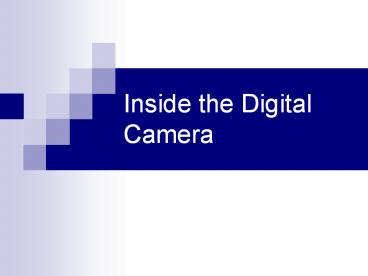Inside the Digital Camera - PowerPoint PPT Presentation
Title:
Inside the Digital Camera
Description:
Inside the Digital Camera Types of Digital Cameras The quality of a lense is determined by the manufacture and the construction In the diagram at the right the lens ... – PowerPoint PPT presentation
Number of Views:702
Avg rating:3.0/5.0
Title: Inside the Digital Camera
1
Inside the Digital Camera
2
Types of Digital Cameras
Pocket Camera
Rangefinder
SLR Like
DSLR
3
Key Features of Digital Cameras (front view)
Rangefinder
Microphone
Flash
AF Assist Beam
Lens
Grip
4
Top View
Shutter Button
Shutter Button
Zoom Lever
Speaker
Self-timer Burst Button
Off Button
Mode Lever
Self-timer Burst Button
Mode Dial
Flash/Mic Button
Flash Button
Mode Dial Power Button
5
Back View
View Finder
Speaker
Zoom Lever
View Finder
Omni Selector
4 Way Control
LCD Screen
LCD Screen
OK Button
6
Back View close-up
delete
I
menu
review
7
Left Side
8
Right Side
9
Bottom Side
10
Digital Camera
Digital cameras work in the same way that a film
camera works.
The difference between the two is what you find
inside.
11
(No Transcript)
12
Digital Camera
How it works
Step 1. Point to the image to photograph and
take picture. Light passes into the lens of the
camera
13
Lens Construction
- The quality of a lense is determined by the
manufacture and the construction - In the diagram at the right the lens has 6
elements in 4 groups - Another feature of any lens is its aperture, the
size of the opening that allows light through
14
Lens Construction
- The aperture of a lens is measured in f-stops
- The smaller the f-stop number the more light is
admitted - F-stop measurement is based on lens diameter and
focal length
15
Digital Camera
Step 2. Image is focused on a chip called a
charge-coupled device (CCD).
16
- This is what a CCD looks like
17
Digital Camera
Step 3. CCD generates an analog signal that
represents the image
18
Digital Camera
Step 4. The Digital Signal Processor (DSP)
converted the analog information to digital
information, enhances it and prepares it for
output.
DSP
19
Digital Camera
Step 6. The formatted digital image is stored
on miniature mobile storage media in the camera.
DSP
20
Memory Card Types
Secure Data (SD)
Smart Media (SM)
xD Picture Card (xD)
MultiMedia (MM)
Compact Flash
Memory Stick (MS)
21
Camera Resolution
- Factors that effect resolution
- Shutter speed
- Camera motion
- Subject motion
- Lighting/contrast
- Focus
- Optics
- Megapixels
22
Digital Camera Specifications
Cannon S3 IS
Kodak C340
Image Capture Device
Approx. 6.0 Megapixels
Approx. 5.0 Megapixels
Still Format
Exif 2.2 (JPEG)
JPEG/EXIF v 2.21
Lens
6.0-72.0mm f/2.7-3.5 (35mm film equivalent
36-432mm)
f/2.74.6 (34102 mm, 35mm equivalent)
CCD
1/2.5 inch type Charge Coupled Device (CCD)
1/2.5 in. type (5.36 M total pixels)
23
Digital Camera Specifications
Cannon S3 IS
Kodak C340
Zoom
12X Optical
3X optical
Shutter Speed
15-1/3200 sec. (settable in Tv or M)
41/1400 sec.
ISO (film speed)
Auto, High ISO Auto, ISO 80/100/200/400/800
equivalent
ISO equivalent 80160 (automatic, still), 80200
(sports) and 80,100, 200, 400 (manual)
Exposure metering
Evaluative, Center-weighted average, Spot
Metering frame is fixed to the center or linked
to the AF frame
center-weighted
24
Digital Camera Specifications
Cannon S3 IS
Kodak C340
Focus Range
Normal 1.6 ft./50cm-infinity (WIDE), 3.0
ft./90cm-infinity (TELE)
Standard23.6 in. (60 cm) to infinity
Macro 3.9 in.-1.6 ft./10-50cm (WIDE)
Close-up wide528 in. (1370 cm)
Super Macro 0-3.9 in./0-10cm (WIDE)
Close up tele928 in. (2270 cm)
Color Modes
Vivid, Vivid Blue, Vivid Green, Vivid Red,
Neutral, Sepia, Black White, Positive Film,
Lighter Skin Tone, Darker Skin Tone, Custom Color
color, black and white, sepia
25
Digital Camera Specifications
Cannon S3 IS
Kodak C340
Flash Range
Normal 1.6-17 ft./50cm - 5.2m (W), 3.0-13
ft./90cm-4.0m (T) Macro 1.0-1.6 ft./30-50cm (W)
(when sensitivity is set to ISO Auto)
wide211.8 ft (0.63.6 m) tele26.9 ft
(0.62.1 m)
Auto Focus
TTL Autofocus (continuous/single)
TTL-AF
Cost (on line)
328 - 850
109 - 227































